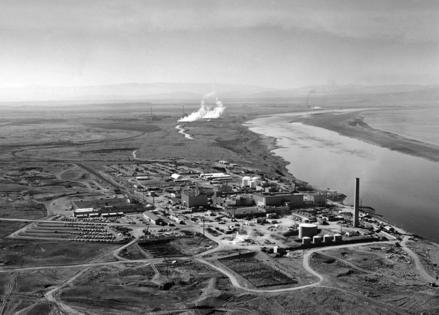Here's what the Trump administration proposes spending on Washington's toxic Hanford nuclear site
Published in News & Features
TACOMA, Wash. — The Trump administration showed support for environmental cleanup at Hanford in its initial proposal for fiscal 2026 funding, calling for a much higher annual budget than it did during Trump’s previous term as president.
The support for Hanford came as elsewhere in the proposed budget the Trump administration wants a $163 billion cut for non-defense domestic spending, a reduction of almost 23% from current spending.
The budget proposal released Friday calls for the Hanford nuclear site in Eastern Washington to receive funding at the same level as the current fiscal year.
It’s the only Department of Energy cleanup site the Trump administration calls out for steady funding, saying that 13 other sites and the Waste Isolation Pilot Plant in New Mexico should be slashed a combined $389 million.
The details of the current fiscal 2025 budget are not yet final but Hanford is expected to receive at least $3 billion and possibly more this year.
The House proposed a $3 billion budget and the Senate proposed a $3.2 billion budget for Hanford.
In Trump’s previous term as president, his administration called for annual Hanford budgets of $1.8 billion to $2.2 billion.
Congress approved higher spending for Hanford those years than proposed by the Trump administration, thanks to the work of Sens. Patty Murray and Maria Cantwell, both D-Wash., and Rep. Dan Newhouse, R-Wash.
In 2024, under the Biden presidency, Hanford for the first time received a budget that exceeded $3 billion at $3.05 billion.
Project 2025 on Hanford site
Project 2025, which has served as a blueprint for some policies in the current Trump administration, calls for accelerating the environmental cleanup of DOE sites.
Getting cleanup done sooner could save taxpayers $500 billion over the long run and reduce risk from contaminated sites, even if more money is spent on cleanup in the near term, according to Project 2025.
Up to half of Hanford’s annual budget goes to maintenance, such as security, fire, utilities, roads, and more, while environmental cleanup is being done, according to the Washington state Department of Ecology, a Hanford regulator.
The 586-square-mile Hanford site adjacent to Richland was used from World War II through the Cold War to produce nearly two-thirds of the plutonium for the nation’s nuclear weapons program.
The work left 56 million gallons of radioactive waste in underground tanks prone to leaking; contaminated soil and water; buried radioactive waste; and contaminated and obsolete buildings, including chemical processing plants that are longer than the Seattle Space Needle is tall.
DOE is planning for cleanup work at Hanford in the near term that is expected to cost more than $3 billion annually.
That includes starting to glassify some of the least radioactive tank waste at the vitrification plant this summer. Some of the waste has been stored in underground tanks since the 1940s, and the vitrification plant has been under construction since 2002.
In addition, construction needs to be ramped up to finish the vitrification plant facility that will turn some of the most radioactive waste into a stable glass form starting by a 2033 deadline set by the federal court.
Other additional projects that will require funding include preparing to package and ship transuranic waste to the national Waste Isolation Pilot Plant in New Mexico. Hanford’s transuranic waste is typically debris contaminated with plutonium.
And DOE and Ecology have agreed to retrieve the least radioactive waste from 22 tanks that are some of the farthest from the vitrification plant for grouting and shipping for disposal outside of Washington.
Long-term Hanford cost estimate
Long term, significantly higher budgets would be needed for Hanford to finish cleanup as projected in its latest “lifecycle” cost and schedule report released last month.
It said remaining cleanup work could range from $364 billion to $640 billion, with the higher number completing most cleanup as of 2086.
At the low range, it projected spending peaking at $8 billion per year with spending approaching $4.5 billion to up to $5 billion annually for most of the remainder of this decade into the 2040s.
Under the high range estimate, spending would peak at $13 billion in 2075 with $6 billion to $8 billion needed annually for most of the remainder of the decade to 2050, when spending would need to increase.
The budget proposal from the Trump administration for fiscal 2026 will be used by the House and Senate to develop their budget proposals before a final budget is determined.
What the administration has released so far is sometimes called a “skinny” budget because it has limited details.
It does not give specifics on what the 14 active DOE environmental cleanup sites and the Waste Isolation Pilot Plant, which disposes of transuranic waste left from nuclear weapons projects, will receive, other than to say Hanford funding will be maintained at the current level.
It also does not include funding levels for specific projects at Hanford or other sites.
Of the $389 million cut for sites other than Hanford, $178 million would be due to a transfer of responsibility for cleanup at the Savannah River, S.C., site from the DOE Office of Environmental Management to the National Nuclear Security Administration for developing plutonium pit production capabilities.
Pacific Northwest National Laboratory
In other DOE spending, the Trump administration proposed cutting $1.1 billion from the Office of Science, which is responsible for Pacific Northwest National Laboratory in Richland.
The reduction would come from funding for “climate change” and what it called “Green New Scam” research, but provide funding to remain competitive in other areas, including high-performance computing, artificial intelligence, quantum information science and fusion.
A memo from the White House Office of Management and Budget says that the “skinny” budget was released before the full fiscal proposal for fiscal 2026 to allow congressional committees to start debating and considering appropriation bills.
The White House said it found fiscal 2025 spending laden with items “contrary to the needs of ordinary working Americans and tilted toward funding niche non-governmental organizations and institutions of higher education committed to radical gender and climate ideologies antithetical to the American way of life.”
While cutting non-defense domestic spending, it would increase defense spending 13% to $1 trillion and invest $175 billion to secure the border, the memo said.
_____
© 2025 The News Tribune (Tacoma, Wash.). Visit www.TheNewsTribune.com. Distributed by Tribune Content Agency, LLC.







Comments